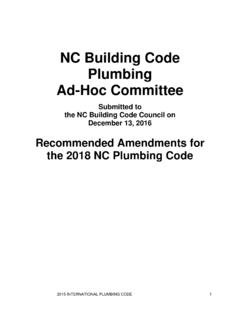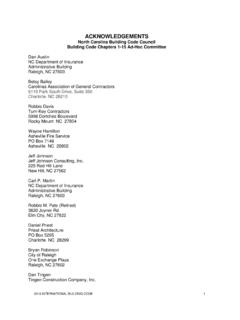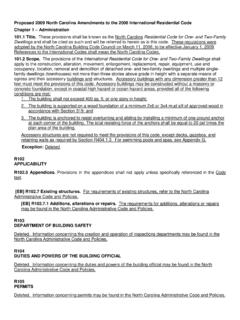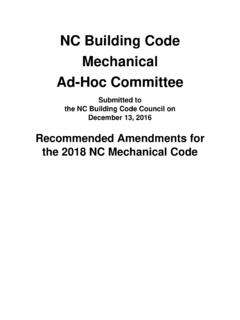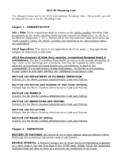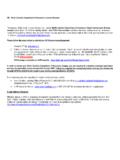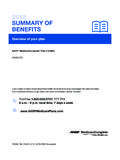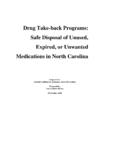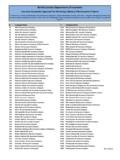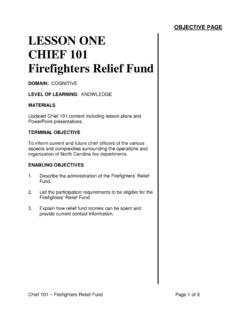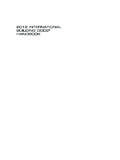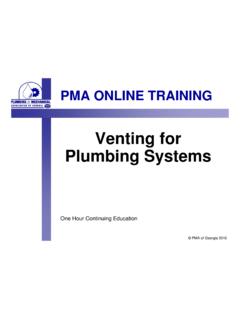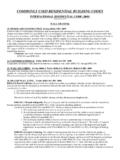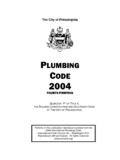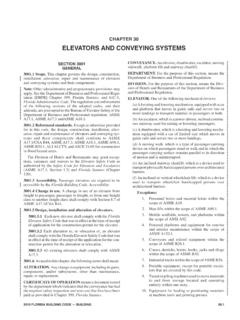Transcription of North Carolina Department of Insurance - NCDOI
1 chapter 1 Title. These regulations shall be known as the North Carolina Plumbing code as adopted by the North Carolina building code Council on March 11, 2008, to be effective January 1, 2009. References to the International Codes shall mean the North Carolina Codes. The North Carolina amendments to the International Codes are underlined. Scope. The provisions of this code shall apply to the erection, installation, alteration, repairs, relocation, replacement, addition to, use or maintenance of plumbing systems within this jurisdiction. This code shall also regulate nonflammable medical gas, inhalation anesthetic, vacuum piping, nonmedical oxygen systems and sanitary and condensate vacuum collection systems. The installation of fuel gas distribution piping and equipment, fuel-gas-fired water heaters and water heater venting systems shall be regulated by the International Fuel Gas code .
2 Exception: Deleted. Appendices. Provisions in the appendices shall not apply unless specifically adopted or referenced in this code . Requirements of other State agencies, occupational licensing boards, or commissions. The North Carolina State building Codes do not include all additional requirements for buildings and structures that may be imposed by other State agencies, occupational licensing boards, and commissions. It shall be the responsibility of a permit holder, design professional, contractor, or occupational license holder to determine whether any additional requirements exist. SECTION 103 Department OF PLUMBING INSPECTION Deleted. See the North Carolina Administrative code and Policies. SECTION 104 DUTIES AND POWERS OF THE code OFFICIAL Deleted. See the North Carolina Administrative code and Policies. SECTION 106 PERMITS Deleted.
3 See the North Carolina Administrative code and Policies. SECTION 107 INSPECTIONS AND TESTING Deleted. See the North Carolina Administrative code and Policies. SECTION 108 VIOLATIONS Deleted. See the North Carolina Administrative code and Policies. SECTION 109 MEANS OF APPEAL Deleted. See the North Carolina Administrative code and Policies. chapter 2 BATTERY OF FIXTURES. Any group of two or more similar adjacent fixtures which discharge into a common horizontal waste or soil branch. BRANCH INTERVAL. A distance along a soil or waste stack corresponding in general to a story height, but not less than 8 feet (2438 mm), within which the horizontal branches from one floor or story of a structure are connected to the stack. building DRAIN. That part of the lowest piping of a drainage system that receives the discharge from soil, waste and other drainage pipes inside and that extends to 10 feet (3048 mm) beyond the walls of the building and conveys the drainage to the building sewer.
4 INDIRECT WASTE RECEPTOR. A plumbing fixture designed specifically to collect and dispose of liquid waste from other plumbing fixtures, plumbing equipment or appliances which are required to discharge to the drainage system through an air gap. The following type fixtures fall within the classification of indirect liquid waste receptors: floor sinks, mop receptors, service sinks, and standpipe drains with integral air gaps. LABELED. Equipment, devices, fixtures or materials bearing the label of an approved agency. PIPE SIZES. For the purposes of determining the minimum size of pipe required, cross sectional areas are the essential characteristic, not the pipe diameter. Therefore, when in the code , it is instructed to increase by one pipe size we should presume the availability of pipe sizes that may not be readily available.
5 Presume the commercial availability of pipe sizes , , 1, 1 , 1 1/2 , 2, 2 , 3, 3 , 4, 4 , 5, 6, 7, 8, 9, 10. REGISTERED DESIGN PROFESSIONAL. An individual who is registered or licensed to practice his respective design profession as defined by the statutory requirements of the professional registration laws of the state or jurisdiction in which the project is to be constructed. Design by a Registered Design Professional is not required where exempt under the registration or licensure laws. SCUPPER. An opening in a wall or parapet that allows water to drain from a roof. TOILET. Water closet and frequently, a lavatory, but not a bathtub, shower, spa or similar bathing fixture. TOILET ROOM. A room containing a water closet, and frequently, a lavatory, but not a bathtub, shower, spa or similar bathing fixture. Water service pipe. The pipe from the water main or other source of potable water supply, or from the meter when the meter is at the public right of way, to the water distribution system of the building served.
6 Water service pipe shall terminate 5 feet outside the foundation wall. chapter 3 Connections to the sanitary drainage system. All plumbing fixtures, drains, appurtenances and appliances used to receive or discharge liquid wastes or sewage shall be directly connected to the sanitary drainage system of the building or premises, in accordance with the requirements of this code . This section shall not be construed to prevent the indirect waste systems required by chapter 8. All drain, waste and vent piping associated with gray water recycling systems shall be installed in full compliance with this code . Pipe, tube and fitting sizes. See chapter 2, Definitions, Pipe sizes. Detrimental or dangerous materials. Ashes, cinders or rags; flammable, poisonous or explosive liquids or gases; oil, grease or any other insoluble material capable of obstructing, damaging or overloading the building drainage or sewer system, or capable of interfering with the normal operation of the sewage treatment processes or private disposal system, shall not be deposited, by any means, into such systems.
7 Identification. Each length of pipe and each pipe fitting, trap, fixture, material and device utilized in a plumbing system shall bear the identification of the manufacturer, and the applicable standard to which it was manufactured. General. Plumbing systems shall be designed and installed in accordance with Sections through and the North Carolina building code , Appendix H to prevent rodents from entering structures. Meter boxes. Deleted. Openings for pipes. In or on structures where openings have been made in walls, floors or ceilings for the passage of pipes, such openings shall be closed and protected by the installation of approved metal collars or other approved materials that are securely fastened to the adjoining structure. Pipes through or under footings or foundation walls. Any pipe that passes within 12 inches (305 mm) under a footing or through a foundation wall shall be provided with a relieving arch, or a pipe sleeve pipe shall be built into the foundation wall.
8 The sleeve shall be two pipe sizes greater than the pipe passing through the wall. Piping shall not be run under pier footing (refer to 307). Freezing. The top of water pipes, installed below grade outside the building , shall be below the frost line or a minimum of 12 inches below finished grade whichever is greater. Water pipes installed in a wall exposed to the exterior shall be located on the heated side of the wall insulation. Water piping installed in an unconditioned attic or unconditioned utility room shall be insulated with an insulation having a minimum R factor of determined at 75-degrees-F in accordance with ASTM C-177. NOTE: These provisions are minimum requirements which have been found suitable for normal weather conditions. Abnormally low temperatures for extended periods may require additional provisions to prevent freezing.
9 Frost protection. No traps of soil or waste pipe shall be installed or permitted outside of a building , or concealed in outside walls or in any place where they may be subjected to freezing temperatures, unless adequate provision is made to protect them from freezing. Waste and soil piping leaving the building shall have a minimum cover of 3 inches. Protection of components of plumbing system. Components of a plumbing system installed along alleyways, driveways, parking garages or other locations exposed to damage shall be recessed into the wall or otherwise protected in an approved manner. Exception: One-and two-family dwellings and townhouses. Cutting, notching or bored holes. A framing member shall not be cut, notched or bored in excess of limitations specified in the International building code , the North Carolina Residential code or Appendix F in this code .
10 Interval of support. Pipe shall be supported in accordance with Table , or the manufacturer s installation instructions. Exception: The interval of support for piping systems designed to provide for expansion/contraction shall conform to the engineered design in accordance with Section Location. For plastic pipe sizes greater than 6 inches (152 mm), and other pipe sizes greater than 4 inches (102 mm), restraints shall be provided for drain pipes at all changes in direction and at all changes in diameter greater than two pipe sizes. Braces, blocks, rodding, backfill and other suitable methods as specified by the coupling manufacturer shall be utilized. Stacks. Bases of stacks shall be supported by the building structure, virgin or compacted earth, or other suitable material to adequately support the weight of the piping.
